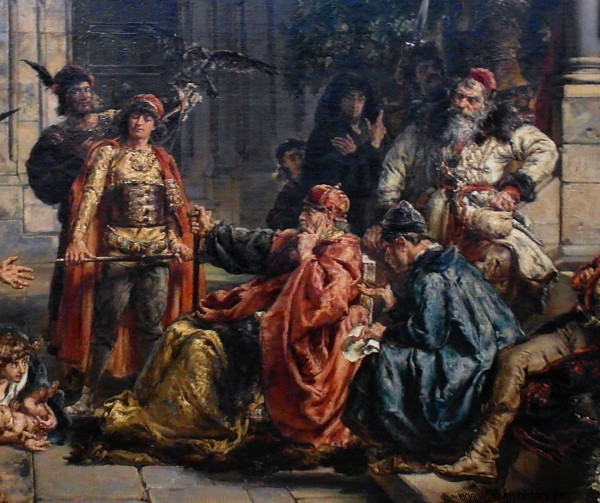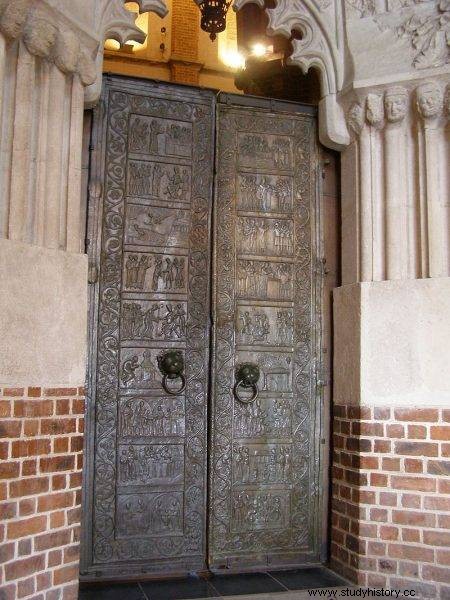The story of the life and death of Saint Adalbert has survived to our times in an unusual form - it was presented on the Gniezno Doors. To this day, it is not known who commissioned their implementation and by whom they were made. However, despite some ambiguities, this unique monument of culture, unique on a global scale, arouses constant admiration not only of the faithful and pilgrims, but also tourists and art lovers.
It is difficult to find a history textbook without a mention of the Gniezno Doors. They belong to the elements that make up the history of the beginnings of the Polish state, including its cultural origins.

The history of the life and death of Saint Adalbert has survived to our times in an unusual form - it was presented at the Gniezno Doors.
In the past, the process of Christianization had - apart from the religious aspect - also an educational aspect, because monks, as one of the few in contemporary society, could write and read. People who are illiterate could learn about various phenomena, figures or religious and historical events thanks to picture representations. And this is exactly the story in the paintings of the Gniezno Doors.
The door that says
To this day, the exact time and place of the construction of the Gniezno Doors has not been established. For many years it was believed that Bolesław Krzywousty was responsible for the idea, but more recent studies indicate that the famous gate could not be built before 1170. For this reason, the initiative is attributed to the son of Krzywousty, Mieszko III the Old. The performers are also unknown, but it is assumed that there were at least three artists, as evidenced by the results of the analysis of the style of figural representations.
The medieval work can be treated as an example of didactic art, in which the narrative illustrates important history. This particular monument is, however, very unusual, because at that time such monumental doors were mainly biblical scenes - about the creation of the world or the Passion of the Lord - while in Gniezno we get to know the story of one person's life - Saint Adalbert. And although this figure is considered significant, it cannot be denied that the total sacrifice of such a majestic object to her is at least surprising.

To this day, the exact time and place of the construction of the Gniezno Doors has not been established. For many years it was believed that Bolesław Krzywousty was responsible for the idea.
The Gniezno Doors consist of eighteen quarters - nine per wing - telling the life of a missionary. Getting to know the story perversely begins at the bottom of the left wing - there we see the birth and adolescence of Wojciech. Then we look at the right wing, on which, following the history from top to bottom, we observe the saint's arrival in Prussia, his mission, and then the martyr's death and redemption of the corpse.
One can quickly notice that the life of Saint Adalbert is reminiscent of the story of Jesus Christ. It is not difficult to see some analogies here, which means that the figure of a medieval missionary acquires almost divine meaning, and the Gniezno gate outside the historical context takes on a symbolic dimension.
Botched job
Although the Gniezno Doors are one of the most unique monuments of European art, some researchers admit that they were not made very carefully. A glance is enough to notice that the wings differ significantly, especially in dimensions. The left wing is 328 cm high and 84 cm wide. The right wing is smaller - its height is 323 cm, width - 83 cm.
Moreover, apparently no effort was made to thoroughly mix the molten metal, or else the proportions of copper, tin, and lead were used because chemical analyzes show that the right wing, which is brighter, contains a trace amount of lead. The left wing already has more of it, which makes it darker and better preserved, and the reliefs are clearer.

A glance is enough to notice that the wings differ significantly, especially in dimensions.
In addition, the left wing was completely cast, and in those days was both a big challenge and an extraordinary achievement . On the other hand, the quarters for the right wing were cast separately and only then joined together - however, the connections are not noticeable.
Despite some shortcomings, these monumental doors, made of metal rather than wood, must have aroused great admiration in the Middle Ages. Their sheer size could make the faithful feel not only tiny, but also experience a culture shock when looking at them. They certainly did not watch such works on a daily basis.
Saint accompanied by a monkey
The uniqueness of the Gniezno Doors is evidenced by both the scenes depicting the life of Saint Adalbert and the manner in which this work was performed, as well as the decorative elements. The quarters showing individual events in the missionary's life are surrounded by a border, i.e. a frame with figural, plant and animal motifs. Such an artistic commentary emphasizes the symbolic and allegorical dimension of the Romanesque monument.
A decorative border composed of images of flowers, leaves and fruit winds around eighteen sections. Images of human figures and animals - both real and fantastic, known from myths, legends and fairy tales - were woven between the vegetation. So you can see lions, snakes, dogs, ravens, peacocks, deer or dragons, centaurs and other fantastic creatures that are the result of the artist's artistic imagination.
According to Joanna Łenyk-Barszcz, author of the book "Secrets of Works of Art", the most interesting on the Gniezno Doors is the image of… a monkey. The depictions of this exotic animal were rare not only in Poland, but also in the entire Christian world.
In the Middle Ages, the monkey had three symbolic meanings. According to the first, the oldest and lasted until the fourteenth century, she personified Satan. The second meaning pointed to the symbol of the sinner. And according to the third, she was a distorted human image. We can only guess that the creators of the romanesque door decided to put the image of a monkey on them for a reason. This imposes a certain interpretation of the historic work - it was emphasized in this way that the goal of Saint Adalbert's life was to convert sinners, which, moreover, led him to martyrdom.
